A Study on Sustainable Entrepreneurial Behavior in China from Multiple Perspectives
Abstract
:1. Introduction
2. Research Hypotheses
2.1. Entrepreneurial Intention, Risk Perception, and Sustainable Entrepreneurship Behavior
2.2. Institutional Environment and Sustainable Entrepreneurship Behavior
3. Study Design
3.1. Data Collection
3.2. Variable Design
3.3. Analysis Methods
4. Study Results
4.1. Reliability and Validity Tests
4.2. SEM Analysis
4.3. Empirical Results
4.3.1. Path Analysis
4.3.2. Mediating Effect Assessment
4.3.3. Moderating Effect Assessment
5. Recommendations
5.1. Improve Comprehensive Quality and Risk Perception
5.2. Promote Entrepreneurial Intention
5.3. Provide Institutional Environment
6. Conclusions
6.1. Direct Effect Analysis
6.2. Mediating Effect Analysis
6.3. Moderating Effect Analysis
Author Contributions
Funding
Institutional Review Board Statement
Informed Consent Statement
Data Availability Statement
Conflicts of Interest
References
- Rezaei, A.; Jalalian, A. The influence of the Stockholm Declaration of 1972 on the training and institutionalization of the principles and concepts governing the environment in the field of international law. Environ. Educ. Sustain. Dev. 2018, 2, 83–100. [Google Scholar]
- Start-up Genome. Global Start-Up Ecosystem Report 2019; Startup Genome: Washington, DC, USA, 2019. [Google Scholar]
- State Council of China. Work report of the Chinese government. In Proceedings of the Third Session of the 13th National People’s Congress of China, Beijing, China, 1 September 2020. [Google Scholar]
- Global entrepreneurship monitor. Global Entrepreneurship Monitor 2019/2020 Global Report; Global Entrepreneurship Monitor: San Francisco, CA, USA, 2020. [Google Scholar]
- Global Entrepreneurship Monitor. Global Entrepreneurship Monitor 2020/2021 Global Report; Global Entrepreneurship Monitor: San Francisco, CA, USA, 2021. [Google Scholar]
- Ziolo, M.; Ghoul, M.B. The role of the government in enhancing sustainable entrepreneurship. Int. J. Bus. Glob. 2019, 22, 595–617. [Google Scholar] [CrossRef]
- Bagozzi, R.P.; Baumgartner, J.; Yi, Y. An investigation into the role of intentions as mediators of the attitude-behavior relationship. J. Econ. Psychol. 1989, 10, 35–62. [Google Scholar] [CrossRef] [Green Version]
- Fiona, T.; Bradley, D.P. From poles to wholes: Facilitating an integrated approach to sustainable entrepreneurship. World Rev. Entrep. Manag. Sustain. Dev. 2006, 2, 281–294. [Google Scholar]
- Schaltegger, S.; Wagner, M. Sustainable entrepreneurship and sustainability innovation: Categories and interactions. Bus. Strategy Environ. 2011, 20, 281–294. [Google Scholar] [CrossRef]
- Liu, F. A Study on the Influence Mechanism of Personality and Entrepreneurial Environment on College Students’ Entrepreneurship Motivation. Master’s Thesis, Hubei University, Wuhan, China, 17 May 2017. [Google Scholar]
- Dong, Y.Y. Research on the Influence Mechanism of Founder Identity on Sustainable Entrepreneurial Behavior. Master’s Thesis, Zhongnan University of Economics and Law, Wuhan, China, 15 May 2020. [Google Scholar]
- Kouriloff, M. Exploring Perceptions of A Priori Barriers to Entrepreneurship: A Multidisciplinary Approach. Entrep. Theory Pract. 2000, 25, 59–80. [Google Scholar] [CrossRef]
- Liu, R.J. The Influence of College Students’ Entrepreneurial Motivation on Entrepreneurial Behavior. Master’s Thesis, Nanchang University, Nanchang, China, 16 May 2019. [Google Scholar]
- He, L.X.; Zhang, Y.L. Entrepreneurial Intention and Behavior: A Clear-set Qualitative Comparative Analysis from the Perspective of Comfort Zone and Affordable Loss. Sci. Sci. Manag. S T 2020, 41, 26–42. [Google Scholar]
- Ma, K.S. Entrepreneurial behavior model based on entrepreneurial tendency. Mod. Bus. 2014, 13, 93–94. [Google Scholar]
- Bird, B. Implementing Entrepreneurial Ideas: The Case for Intention. Acad. Manag. Rev. 1988, 13, 442–453. [Google Scholar] [CrossRef]
- Xiong, J. The Relationship among Personality Traits, Social Support and Entrepreneurial Intention of Higher Vocational Students. Master’s Thesis, Hunan Normal University, Changsha, China, 1 October 2019. [Google Scholar]
- Krueger, N.F. The impact of prior entrepreneurial exposure on perceptions of new venture feasibility and desirability. Entrep. Theory Pract. 1993, 18, 5–21. [Google Scholar] [CrossRef]
- Xiang, Y.Q. Research on the Influencing Factors of Jingmen Young Makers’ Continued Entrepreneur Behavior. Master’s Thesis, Huazhong University of Science and Technology, Wuhan, China, 1 March 2018. [Google Scholar]
- Krueger, N.F.; Reilly, M.D.; Alan, L.C. Competing models of entrepreneurial intentions. J. Bus. Ventur. 2000, 15, 411–432. [Google Scholar] [CrossRef]
- Keh, H.T.; Foo, M.D.; Lim, B.C. Opportunity Evaluation under Risky Conditions: The Cognitive Processes of Entrepreneurs. Entrep. Theory Pract. 2002, 27, 125–148. [Google Scholar] [CrossRef]
- Chen, C.J.; Yang, J.; Yang, J.; Yuan, Y. Analysis on Influencing Factors of College Students’ entrepreneurial risk cognition. Res. High. Educ. Eng. 2018, 1, 176–181. [Google Scholar]
- Sim, B.S.; Laurie, R.W. Determinants of Risky Decision-Making Behavior: A Test of the Mediating Role of Risk Perceptions and Propensity. Acad. Manag. J. 1995, 38, 1573–1592. [Google Scholar]
- Sim, B.S.; Amy, L.P. Reconceptualizing the Determinants of Risk Behavior. Acad. Manag. Rev. 1992, 17, 9–38. [Google Scholar]
- Tuo, S.W. On the theory of expected utility. Times Financ. 2015, 30, 41–42, 47. [Google Scholar]
- Zhang, J.; Zhang, Z.Y.; Wei, X.G.; Kang, K. The Choice Mechanism of Supply Chain Governance Mode: Low Control or High Control?—Empirical Research Based on Multiple Institutional Logics. Forecasting 2018, 37, 25–32. [Google Scholar]
- Busenitz, L.W.; Gómez, C.; Spencer, J.W. Country institutional profiles: Unlocking entrepreneurial phenomena. Acad. Manag. J. 2000, 43, 994–1003. [Google Scholar]
- Liu, Z.Y.; Xu, L.P. Institution and social entrepreneurship: A literature-based Integration Framework. Econ. Manag. 2022, 44, 192–208. [Google Scholar]
- Li, Y.H. Research on Impact of Institutional Environment of Sustainable Development on Entrepreneurial Activities. Master’s Thesis, Beijing Forestry University, Beijing, China, 1 April 2016. [Google Scholar]
- Pekka, S.; Zoltan, J.A.; Robert, W. Exploring country-level institutional arrangements on the rate and type of entrepreneurial activity. J. Bus. Ventur. 2013, 28, 176–193. [Google Scholar]
- Wang, Y.C. Research of the Relationship among Entrepr Eneurial Institutional Environment, Entrepre Neurship and Entrepreneurial Performance. Master’s Thesis, Gansu College of Political Science and Law, Lanzhou, China, 1 May 2019. [Google Scholar]
- Zhang, J.; Kang, K.; Wei, X.G.; Zhang, Z.Y. An Empirical Research of the Effect of Institutional Environments and Risk Perception on Governance Mode of Supply Chain Network. Bus. Rev. 2020, 32, 275–285. [Google Scholar]
- Phan, H.P.; Wong, P.K.; Wang, C.K. Antecedents to Entrepreneurship among University Students in Singapore: Beliefs, Attitudes, and Background. J. Enterprising Cult. 2002, 10, 151–174. [Google Scholar] [CrossRef]
- Ma, K.S.; Qin, R.F.; Hu, P. The Relationship of Risk Propensity and Entrepreneurial Decision: The Mediating Role of Risk Perception. Forecasting 2010, 29, 42–48. [Google Scholar]
- Muñoz, P.; Dimov, D. The call of the whole in understanding the development of sustainable ventures. J. Bus. Ventur. 2015, 30, 632–654. [Google Scholar] [CrossRef] [Green Version]
- Tarka, P. An overview of structural equation modeling: Its beginnings, historical development, usefulness and controversies in the social sciences. Qual. Quant. 2018, 52, 313–354. [Google Scholar] [CrossRef] [PubMed] [Green Version]
- Liu, Y.N. Research on the Mechanism of Entrepreneurial Intention on Entrepreneurial Behavior. Ph.D. Thesis, Jilin University, Changchun, China, 1 June 2018. [Google Scholar]
- Song, G.X. How to transform entrepreneurial intention into entrepreneurial behavior: A study based on action state orientation. J. Bus. Econ. 2022, 3, 16–26. [Google Scholar]
- Zhang, X.E.; Wang, C.; Li, S. Institutional environment, entrepreneurial self-efficacy, and entrepreneurial willingness. Sci. Res. Manag. 2022, 43, 59–66. [Google Scholar]
- Laguía Gonzalez, A.; Jaén, I.; Topa, G.; Moriano, J. University environment and entrepreneurial intention: The mediating role of the components of the theory of planned behaviour/El entorno universitario y la intención emprendedora: El papel mediador de los componentes de la teoría de la acción planificada. Rev. De Psicol. Soc. 2019, 34, 137–167. [Google Scholar] [CrossRef]
- Ying, X.P.; Wang, J.K. The Different Moderating Effect of Entrepreneurial Risk Perception in t Relationship between Female and Male College Students’ Creative Self-efficacy and Entrepreneurial Intention. Chin. Soc. Psychol. Rev. 2020, 2, 113–126+240. [Google Scholar]
- Liang, Y.; Wang, J.Y. Research on the influencing factors of entrepreneurship intention of mainland college students from Hong Kong and Macao under the background of the construction of Guangdong, Hong Kong, and Macao Great Bay Area: From the perspective of Cultivating Innovative Talents. Sci. Technol. Manag. Res. 2021, 12, 149–156. [Google Scholar]
- Wang, J.; Gao, F. Study on the mechanism of rural mass entrepreneurship and innovation cultivation and entrepreneurial willingness. J. Yunnan Agric. Univ. 2021, 5, 138–145. [Google Scholar]
- Fan, J.F.; Gao, F. Effect logic and causal logic: Re-verification of two types of entrepreneurs in small and medium-sized enterprises: The moderating effect of environmental uncertainty perception and entrepreneurial self-efficacy. Sci. Technol. Prog. Policy 2022, 7, 38–47. [Google Scholar]
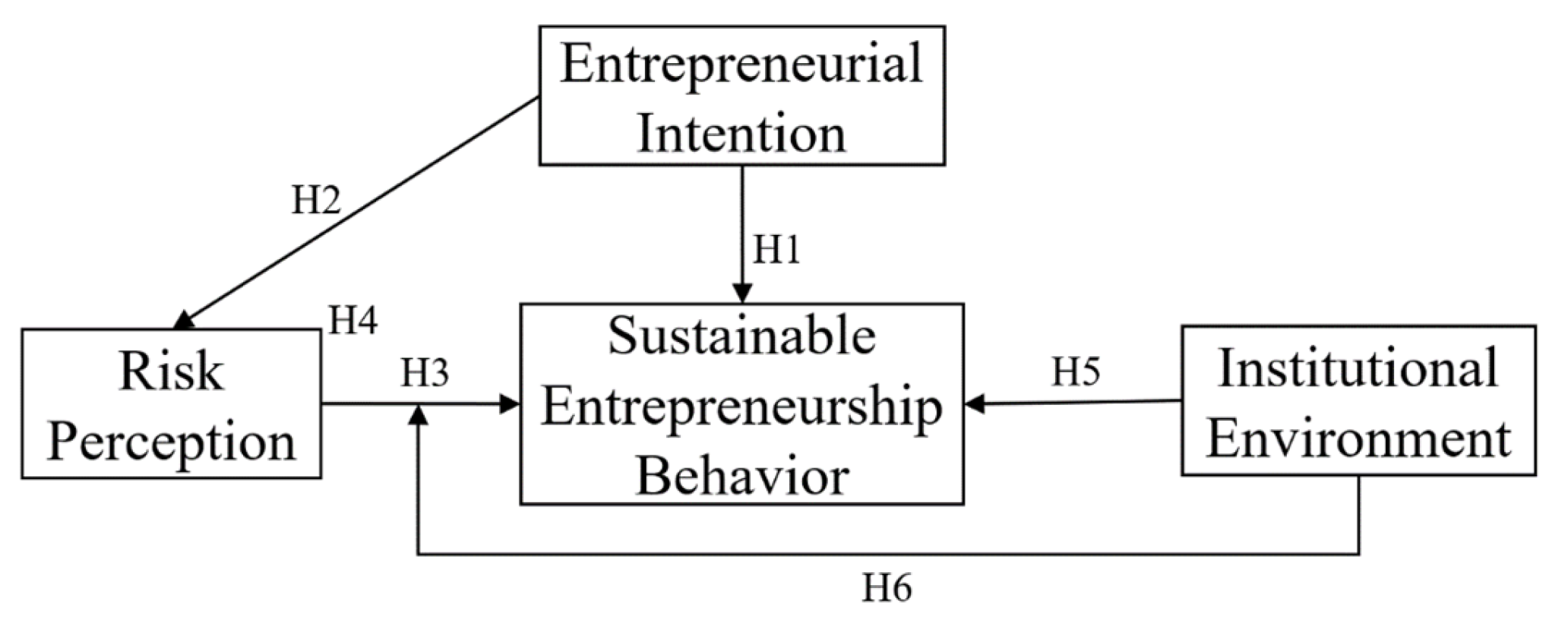
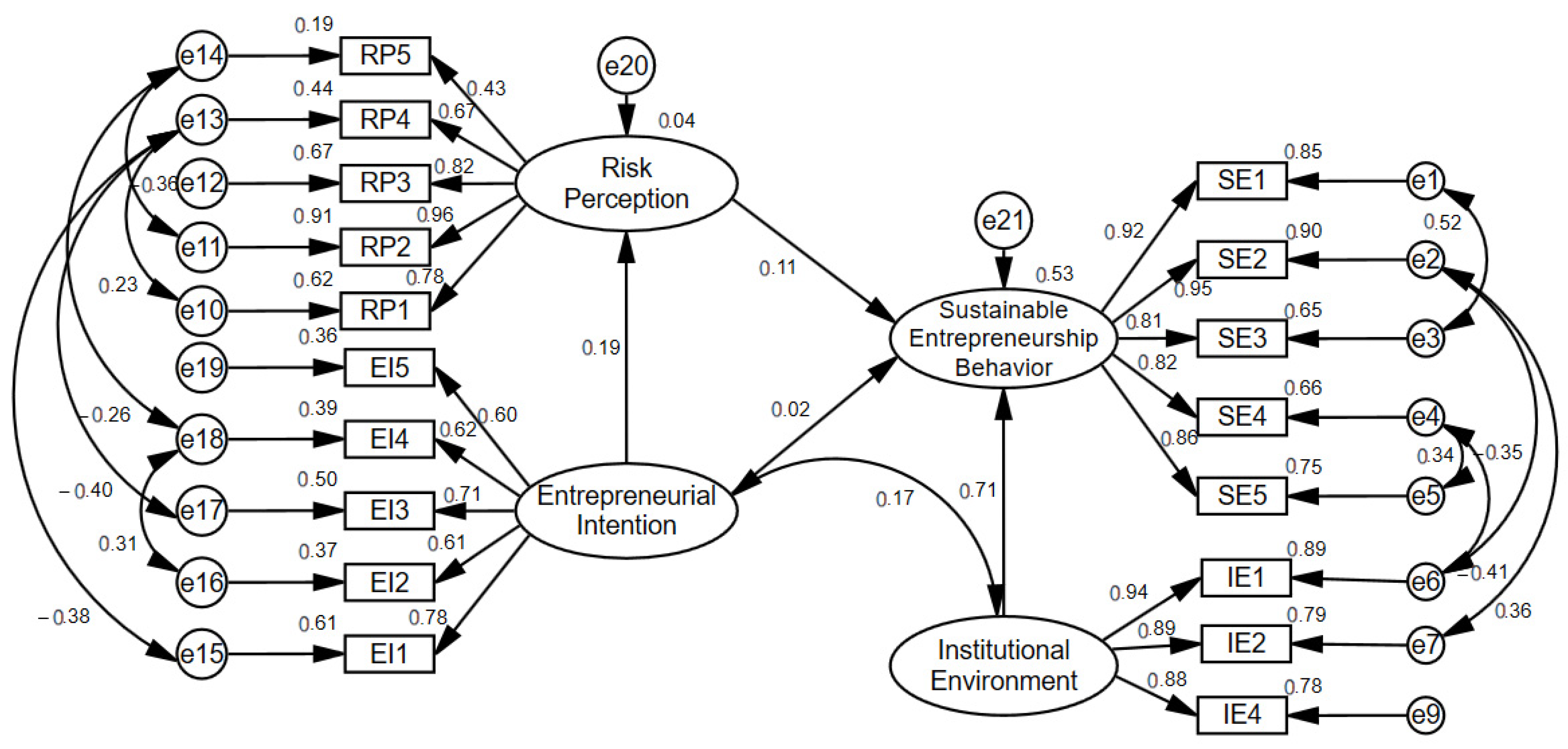

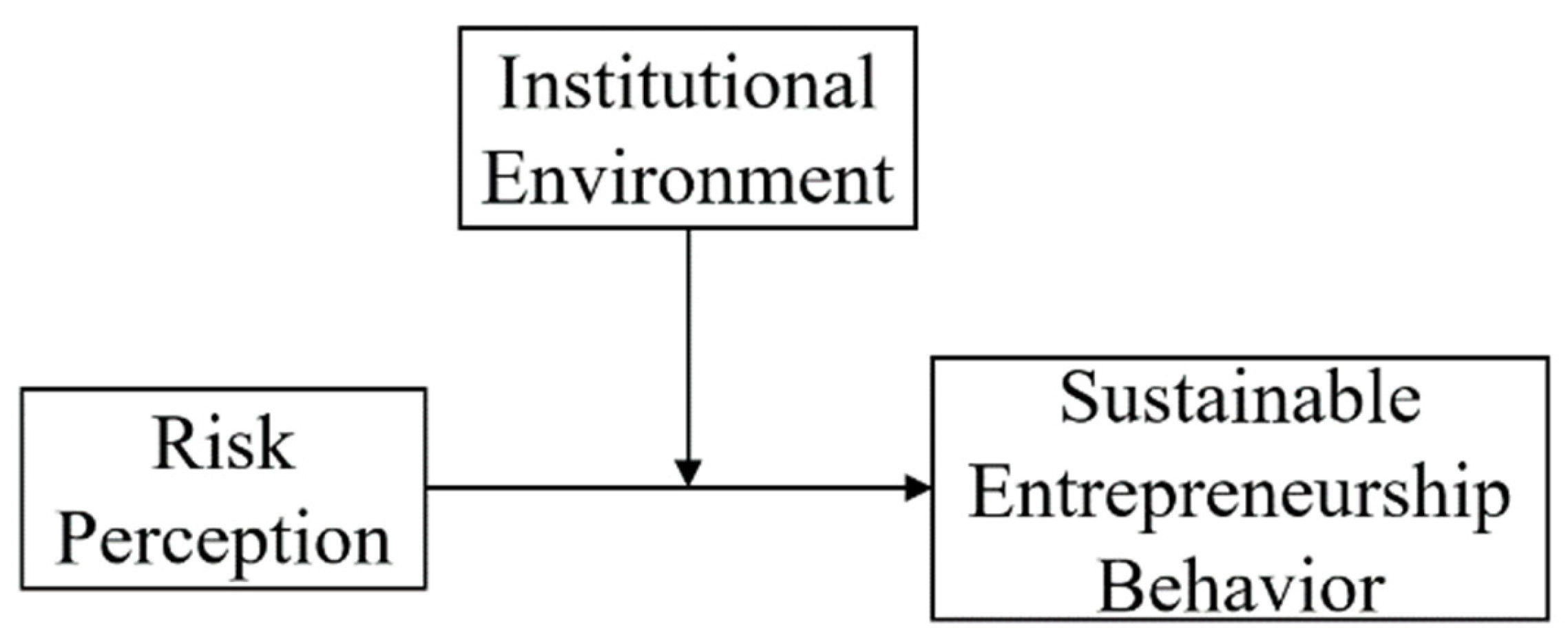
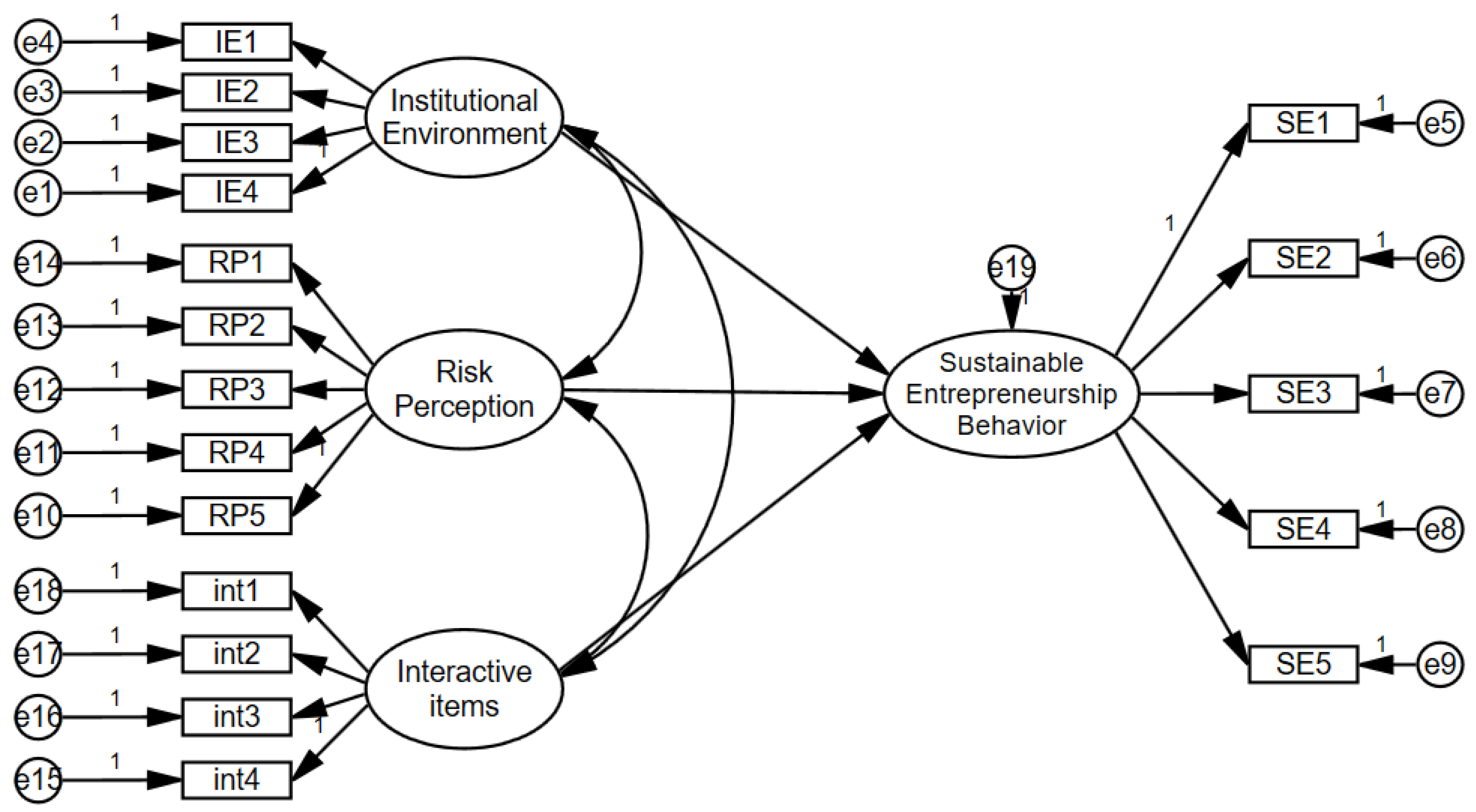
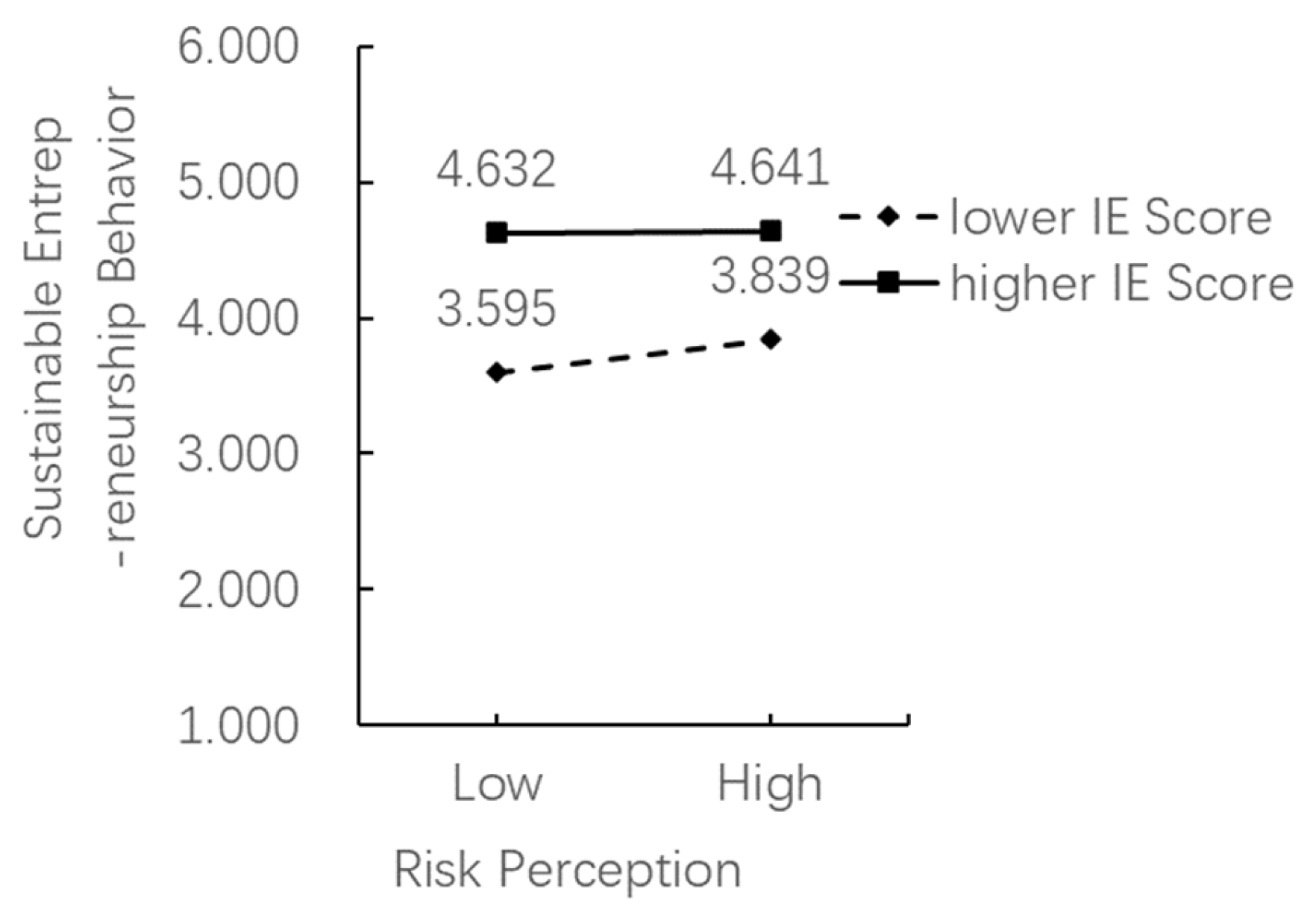
| Variable | Category | Frequency | Proportion |
|---|---|---|---|
| Gender | Male | 101 | 49.75% |
| Female | 102 | 50.25% | |
| Age | 25 and under | 99 | 48.77% |
| 26–35 years old | 31 | 15.27% | |
| 36–45 years old | 35 | 17.24% | |
| Over 45 | 38 | 18.72% | |
| Occupation | Employees of state-owned enterprises, governments, and institutions | 39 | 19.21% |
| Employees of private enterprises | 38 | 18.72% | |
| Freelance | 45 | 22.17% | |
| Student | 81 | 39.90% | |
| Academic Degree | College degree or below | 34 | 16.75% |
| Bachelor degree | 122 | 60.10% | |
| Master degree | 44 | 21.67% | |
| Doctoral degree or above | 3 | 1.48% | |
| Major | Economics and Management | 72 | 35.47% |
| Science and Engineering | 55 | 27.09% | |
| Literature and History | 31 | 15.27% | |
| Medicine and Pharmacy | 28 | 13.79% | |
| Other | 17 | 8.37% | |
| Entrepreneurial experience | Yes | 51 | 25.12% |
| No | 152 | 74.88% |
| Variable | Code | Survey Instrument Statements | Mean | SD | Variance |
|---|---|---|---|---|---|
| Entrepreneurial Intention (EI) | EI1 | Have detailed business plans and ideas. | 2.4 | 0.982 | 0.965 |
| EI2 | Choose to give up doing other things and continue to start a business. | 2.41 | 1.047 | 1.095 | |
| EI3 | Family and friends will want you to start your own business. | 2.39 | 0.918 | 0.843 | |
| EI4 | Hope to contribute to social, ecological, and economic development. | 3.65 | 1.148 | 1.318 | |
| EI5 | Think starting a business is an attractive idea. | 3.29 | 1.185 | 1.405 | |
| Risk Perception (RP) | RP1 | Think the possibility of starting a business failure is high. | 3.99 | 0.89 | 0.792 |
| RP2 | Think the overall risk of starting a business is very high. | 4.06 | 0.784 | 0.615 | |
| RP3 | Think the future development of the enterprise is highly uncertain. | 3.96 | 0.849 | 0.721 | |
| RP4 | Think that starting a business may be a loss. | 3.93 | 0.82 | 0.673 | |
| RP5 | Think the establishment of enterprises faces huge economic losses. | 2.97 | 1.105 | 1.222 | |
| Institutional Environment (IE) | IE1 | The government can provide diversified funding to entrepreneurs. | 3.92 | 0.883 | 0.78 |
| IE2 | The government and relevant departments support and encourage entrepreneurs to carry out innovation and entrepreneurship activities. | 4.04 | 0.911 | 0.83 | |
| IE3 | The policies and programs implemented by the government are very important for the development of enterprises. | 4.19 | 0.709 | 0.503 | |
| IE4 | The government can provide entrepreneurs who fail to start a business with the opportunity to start a second business and help them, which is very important for the development of enterprises. | 4.01 | 0.887 | 0.787 | |
| Sustainable Entrepreneurship Behavior (SE) | SE1 | Creating and distributing economic value among all stakeholders is conducive to the development of enterprises | 4.15 | 0.73 | 0.533 |
| SE2 | Establishing fair transactions with suppliers is conducive to the development of enterprises | 4.21 | 0.736 | 0.541 | |
| SE3 | Protecting or restoring the natural environment is conducive to the development of enterprises | 4.06 | 0.839 | 0.704 | |
| SE4 | Creating more employment opportunities is conducive to the development of enterprises | 4.17 | 0.821 | 0.675 | |
| SE5 | Improving human health and well-being is very important for the development of enterprises | 4.21 | 0.769 | 0.591 |
| KMO Sampling Suitability Quantity | 0.848 | |
|---|---|---|
| Bartlett sphericity test | Approximate chi-square | 3095.557 |
| Freedom | 171 | |
| Significance | 0.000 | |
| Variable | Code | Factor | Cronbach’s α | CR | AVE | |||
|---|---|---|---|---|---|---|---|---|
| 1 | 2 | 3 | 4 | |||||
| Entrepreneurial Intention (EI) | EI1 | 0.821 | 0.810 | 0.8664 | 0.5659 | |||
| EI2 | 0.718 | |||||||
| EI3 | 0.790 | |||||||
| EI4 | 0.751 | |||||||
| EI5 | 0.672 | |||||||
| Risk Perception (RP) | RP1 | 0.857 | 0.827 | 0.8829 | 0.6089 | |||
| RP2 | 0.883 | |||||||
| RP3 | 0.841 | |||||||
| RP4 | 0.753 | |||||||
| RP5 | 0.506 | |||||||
| Institutional Environment (IE) | IE1 | 0.541 | 0.721 | 0.810 | 0.8664 | 0.5659 | ||
| IE2 | 0.728 | |||||||
| IE3 | 0.756 | |||||||
| IE4 | 0.583 | 0.696 | ||||||
| Sustainable Entrepreneurship Behavior (SE) | SE1 | 0.903 | 0.947 | 0.945 | 0.7747 | |||
| SE2 | 0.897 | |||||||
| SE3 | 0.831 | |||||||
| SE4 | 0.873 | |||||||
| SE5 | 0.895 | |||||||
| Title 1 | SE | IE | RP | EI |
|---|---|---|---|---|
| SE | 0.7629 | |||
| IE | 0.712 | 0.8181 | ||
| RP | 0.109 | 0.033 | 0.5657 | |
| EI | 0.023 | 0.173 | 0.189 | 0.4466 |
| Square root of AVE | 0.8734 | 0.9045 | 0.7521 | 0.6683 |
| Index | Fitting Standard | Fitting Value |
|---|---|---|
| χ2/df | <3.0 | 2.181 |
| PGFI | >0.5 | 0.614 |
| RMR | ≤0.1 | 0.093 |
| GFI | >0.9 | 0.882 |
| AGFI | >0.8 | 0.831 |
| RMSEA | <0.08 | 0.076 |
| TLII | >0.9 | 0.934 |
| IFI | >0.9 | 0.950 |
| NFI | >0.9 | 0.911 |
| CFI | >0.9 | 0.949 |
| Estimate | S.E. | C.R. | p | Hypothesis Test Results | |
|---|---|---|---|---|---|
| EI→RP | 0.172 | 0.077 | 2.232 | 0.026 | Supported |
| EI→SE | 0.020 | 0.051 | 0.393 | 0.694 | Unsupported |
| RP→SE | 0.103 | 0.055 | 1.881 | 0.060 | Unsupported |
| IE→SE | 0.570 | 0.051 | 11.236 | *** | Supported |
| Path | Effect | Effect Value | S.E. | Bootstrapping 95% | ||
|---|---|---|---|---|---|---|
| Lower Bound | Upper Bound | p | ||||
| EI→RP→SE | Total Effect (TE) | 0.136 | 0.105 | −0.026 | 0.319 | 0.163 |
| Indirect Effect (IE) | 0.045 | 0.042 | 0.001 | 0.150 | 0.089 | |
| Direct Effect (DE) | 0.091 | 0.087 | −0.051 | 0.237 | 0.281 | |
| Coeff | Se | t | p | LLCI | ULCI | |
|---|---|---|---|---|---|---|
| IE→SE | 0.092 | 0.052 | 1.774 | 0.078 | −0.010 | 0.194 |
| RP→SE | 0.596 | 0.047 | 12.591 | 0.000 | 0.503 | 0.689 |
| IE×RP→SE | −0.111 | 0.038 | −2.885 | 0.004 | −0.187 | −0.035 |
| IE | Effect | se | T | p | LLCI | ULCI |
|---|---|---|---|---|---|---|
| −0.690 | 0.672 | 0.047 | 14.296 | 0.000 | 0.580 | 0.765 |
| 0.000 | 0.596 | 0.047 | 12.591 | 0.000 | 0.503 | 0.689 |
| 0.690 | 0.519 | 0.061 | 8.571 | 0.000 | 0.400 | 0.639 |
Publisher’s Note: MDPI stays neutral with regard to jurisdictional claims in published maps and institutional affiliations. |
© 2022 by the authors. Licensee MDPI, Basel, Switzerland. This article is an open access article distributed under the terms and conditions of the Creative Commons Attribution (CC BY) license (https://creativecommons.org/licenses/by/4.0/).
Share and Cite
Yang, J.; Ai, J.; Fan, L. A Study on Sustainable Entrepreneurial Behavior in China from Multiple Perspectives. Sustainability 2022, 14, 6952. https://doi.org/10.3390/su14126952
Yang J, Ai J, Fan L. A Study on Sustainable Entrepreneurial Behavior in China from Multiple Perspectives. Sustainability. 2022; 14(12):6952. https://doi.org/10.3390/su14126952
Chicago/Turabian StyleYang, Jiaqi, Jun Ai, and Linjie Fan. 2022. "A Study on Sustainable Entrepreneurial Behavior in China from Multiple Perspectives" Sustainability 14, no. 12: 6952. https://doi.org/10.3390/su14126952
APA StyleYang, J., Ai, J., & Fan, L. (2022). A Study on Sustainable Entrepreneurial Behavior in China from Multiple Perspectives. Sustainability, 14(12), 6952. https://doi.org/10.3390/su14126952






